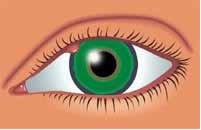Styes |
A stye is a small abscess of the oil gland associated with an eyelash hair follicle. It typically contains bacteria, the cause of staph infections. When a stye develops, a small area of the upper or lower eyelid or the corner of the eye becomes red, tender and swollen. Swelling subsides gradually over a period of days after the stye develops an opening, and the pus is able to drain out.
A chalazion, like a stye, is a swelling within the eyelid caused by inflammation of an oil gland. A chalazion differs from a stye in that it does not contain an active bacterial infection. A chalazion is sometimes the aftereffect of a stye but is less tender and lasts longer.
|

|
Symptoms
Signs of a stye are pain, redness, tenderness and swelling in the area, then a small swollen pimple-like area appears. Sometimes just the stye area is swollen, or the entire eyelid may swell. You may also notice frequent watering in the affected eye.
Treatment
In the early stages, styes may be treated with the repeated use of warm compresses for 15 - 20 minutes. This helps to reduce the swelling and makes the lid more comfortable. However, if the stye does not diminish or recurs, medical attention may be necessary. This may include draining the stye along with the use of antibiotic and anti-inflammatory medications. Styes formed inside the eyelid either disappear completely or rarely rupture on their own, and they can be more serious. These styes may need to be opened and drained by your eye care practitioner.
|
|
|

